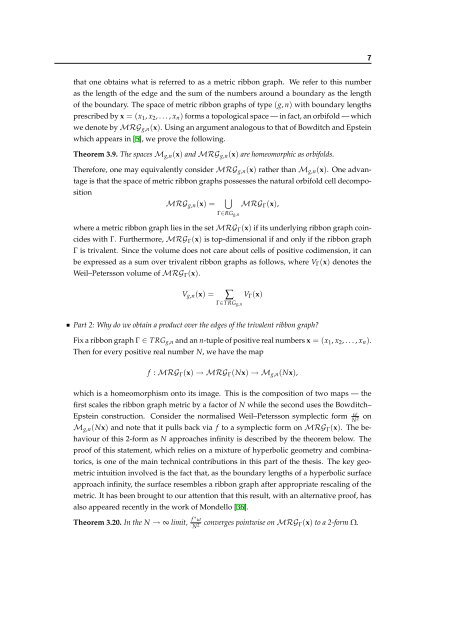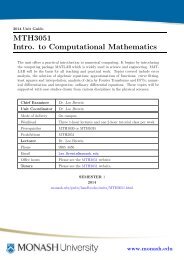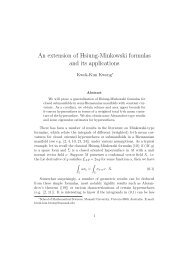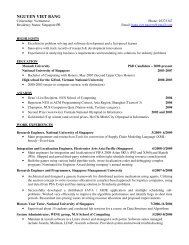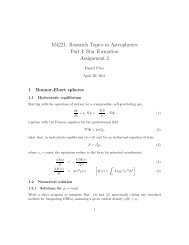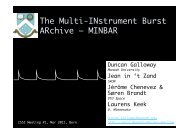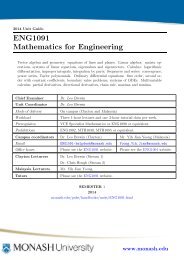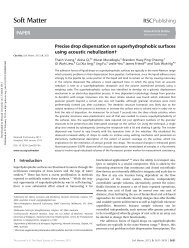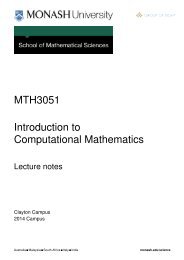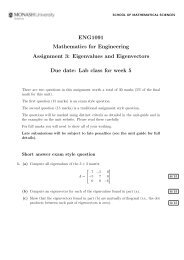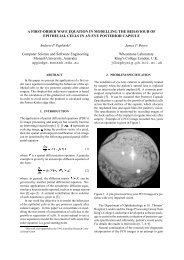Intersection theory on moduli spaces of curves ... - User Web Pages
Intersection theory on moduli spaces of curves ... - User Web Pages
Intersection theory on moduli spaces of curves ... - User Web Pages
You also want an ePaper? Increase the reach of your titles
YUMPU automatically turns print PDFs into web optimized ePapers that Google loves.
7that <strong>on</strong>e obtains what is referred to as a metric ribb<strong>on</strong> graph. We refer to this numberas the length <strong>of</strong> the edge and the sum <strong>of</strong> the numbers around a boundary as the length<strong>of</strong> the boundary. The space <strong>of</strong> metric ribb<strong>on</strong> graphs <strong>of</strong> type (g, n) with boundary lengthsprescribed by x = (x 1 , x 2 , . . . , x n ) forms a topological space — in fact, an orbifold — whichwe denote by MRG g,n (x). Using an argument analogous to that <strong>of</strong> Bowditch and Epsteinwhich appears in [5], we prove the following.Theorem 3.9. The <strong>spaces</strong> M g,n (x) and MRG g,n (x) are homeomorphic as orbifolds.Therefore, <strong>on</strong>e may equivalently c<strong>on</strong>sider MRG g,n (x) rather than M g,n (x). One advantageis that the space <strong>of</strong> metric ribb<strong>on</strong> graphs possesses the natural orbifold cell decompositi<strong>on</strong>MRG g,n (x) =⋃MRG Γ (x),Γ∈RG g,nwhere a metric ribb<strong>on</strong> graph lies in the set MRG Γ (x) if its underlying ribb<strong>on</strong> graph coincideswith Γ. Furthermore, MRG Γ (x) is top-dimensi<strong>on</strong>al if and <strong>on</strong>ly if the ribb<strong>on</strong> graphΓ is trivalent. Since the volume does not care about cells <strong>of</strong> positive codimensi<strong>on</strong>, it canbe expressed as a sum over trivalent ribb<strong>on</strong> graphs as follows, where V Γ (x) denotes theWeil–Peterss<strong>on</strong> volume <strong>of</strong> MRG Γ (x).V g,n (x) =∑Γ∈TRG g,nV Γ (x)Part 2: Why do we obtain a product over the edges <strong>of</strong> the trivalent ribb<strong>on</strong> graph?Fix a ribb<strong>on</strong> graph Γ ∈ TRG g,n and an n-tuple <strong>of</strong> positive real numbers x = (x 1 , x 2 , . . . , x n ).Then for every positive real number N, we have the mapf : MRG Γ (x) → MRG Γ (Nx) → M g,n (Nx),which is a homeomorphism <strong>on</strong>to its image. This is the compositi<strong>on</strong> <strong>of</strong> two maps — thefirst scales the ribb<strong>on</strong> graph metric by a factor <strong>of</strong> N while the sec<strong>on</strong>d uses the Bowditch–Epstein c<strong>on</strong>structi<strong>on</strong>. C<strong>on</strong>sider the normalised Weil–Peterss<strong>on</strong> symplectic form ω <strong>on</strong>N 2M g,n (Nx) and note that it pulls back via f to a symplectic form <strong>on</strong> MRG Γ (x). The behaviour<strong>of</strong> this 2-form as N approaches infinity is described by the theorem below. Thepro<strong>of</strong> <strong>of</strong> this statement, which relies <strong>on</strong> a mixture <strong>of</strong> hyperbolic geometry and combinatorics,is <strong>on</strong>e <strong>of</strong> the main technical c<strong>on</strong>tributi<strong>on</strong>s in this part <strong>of</strong> the thesis. The key geometricintuiti<strong>on</strong> involved is the fact that, as the boundary lengths <strong>of</strong> a hyperbolic surfaceapproach infinity, the surface resembles a ribb<strong>on</strong> graph after appropriate rescaling <strong>of</strong> themetric. It has been brought to our attenti<strong>on</strong> that this result, with an alternative pro<strong>of</strong>, hasalso appeared recently in the work <strong>of</strong> M<strong>on</strong>dello [36].Theorem 3.20. In the N → ∞ limit, f ∗ ωN 2 c<strong>on</strong>verges pointwise <strong>on</strong> MRG Γ (x) to a 2-form Ω.


